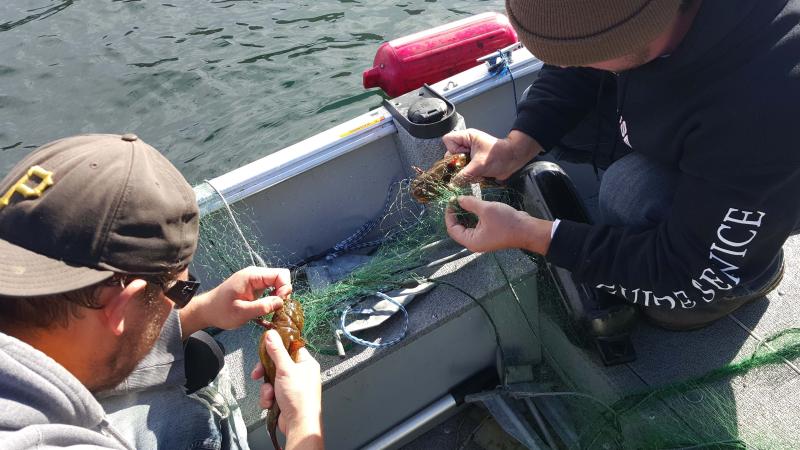February 17, 2016

(In this guest post, one of a series on monitoring and experimentation in the Jefferson Project at Lake George, Bill Hintz, a post-doctoral researcher in the laboratory of project director Rick Relyea, explains how researchers survey the fish of Lake George, and how that effort fits into the overall strategy of the project.)
A thorough understanding of the Lake George ecosystem necessarily includes the study of its fish. Fish strongly influence the abundance and distribution of the organisms they eat, such as other fish species, macro-invertebrates, zooplankton, and aquatic plants. In that way, fish directly or indirectly affect most elements of the Lake George ecosystem. Further, fish are also good indicators of the impacts pollution and invasive species have on aquatic ecosystems, which are critical sources of the water we drink, and our food and recreation.
This understanding of Lake George, which is serving as a test bed for the development of global strategies to protect and conserve our freshwater resources, is a primary goal of the Jefferson Project at Lake George. The project aims to accomplish this through the development of new technologies to study freshwater ecosystems, high-tech modeling, carefully designed experiments, and rigorous surveying efforts. The model system for much of our work is Lake George—an ideal ecosystem to address our scientific objectives and apply what we learn there to other systems around the world. For this understanding, we need to get a close-up and personal look at the biology and abiotic environment of Lake George.
 Toward that end, we began a multi-year, comprehensive survey of the fishes of Lake George in the spring of 2015. The objectives of our survey are to identify 1) what fish species are in the lake, 2) their abundance, 3) their health, and 4) their diets. Such information will allow us to develop a food web model for Lake George. The food web model, in turn, allows us to predict how lake ecosystems may transform with a changing climate, pollution, or invasive species.
Toward that end, we began a multi-year, comprehensive survey of the fishes of Lake George in the spring of 2015. The objectives of our survey are to identify 1) what fish species are in the lake, 2) their abundance, 3) their health, and 4) their diets. Such information will allow us to develop a food web model for Lake George. The food web model, in turn, allows us to predict how lake ecosystems may transform with a changing climate, pollution, or invasive species.
But first things first; we need to catch fish.
We collect fish monthly from spring through fall. We sample throughout the lake in deep and shallow waters using several netting techniques. We can catch tens to hundreds of fish in each sample. We then measure the length and weight of each fish and return it to the water alive. From the length and weight of a fish we can calculate what is called a condition factor, which is one way to determine the overall health of a fish. For example, if a fish is heavy relative to its length, that would suggest there is plenty of food available. The opposite may suggest food resources are scarce, the fish is stressed, or the fish may have a disease. In any case, the condition of a fish can lead to a variety of conclusions, perhaps warranting further investigation.
We harvest a few individuals of each species to examine what they have been eating. We remove the stomachs from the fish and identify and count the contents. Diet information can tell us a lot, including interactions fish have with other organisms and each other. Diets can also reveal unique behaviors, information regarding habitat use, and energy intake. These types of data are important for the development of the Lake George food web model. Fish diets can also tell us how to manage prey resources that increase fish production, which is good for the recreational anglers and commercial fisheries (i.e., food on your table).
We also use harvested fish to determine age and growth rates. To do this, we examine the sagittal otoliths, which are analogous to our inner ear bones (they are more like rocks than bones). They record a fish’s age and growth rate, similar to growth rings on a tree. After the otoliths are processed, they look like a cross section from a tree trunk. We count the rings to estimate the age of the fish, and can use back-calculation techniques to estimate growth rates. This information is essential to understand the overall status of a fish population. For example, a healthy fish population will have the right proportions of young, middle-aged, and old fish. Too many or too few of a particular age category may indicate a stressful environment. Such an environment may be attributed to a number of factors like invasive species and pollution, or natural stressors like competition or predation. (In the image below, the author trains students in sampling techniques.)
To date, we have sampled a variety of fish species—from the biggest lake trout to small minnow species. Data from 2015 are currently being processed and we are primed to continue our survey work in 2016. We also engage local anglers, fishing charters, and state biologists to assist in our efforts to understand the fish and fisheries of Lake George. Our fish surveys are just one piece of a very large puzzle, however. We will combine data from the fish survey with data from surveys of macroinvertebrates, plankton, aquatic plants, and data from the smart sensor network. In doing so, we will develop state-of-the-art models for protecting our freshwater resources—resources so critical to our well-being.

